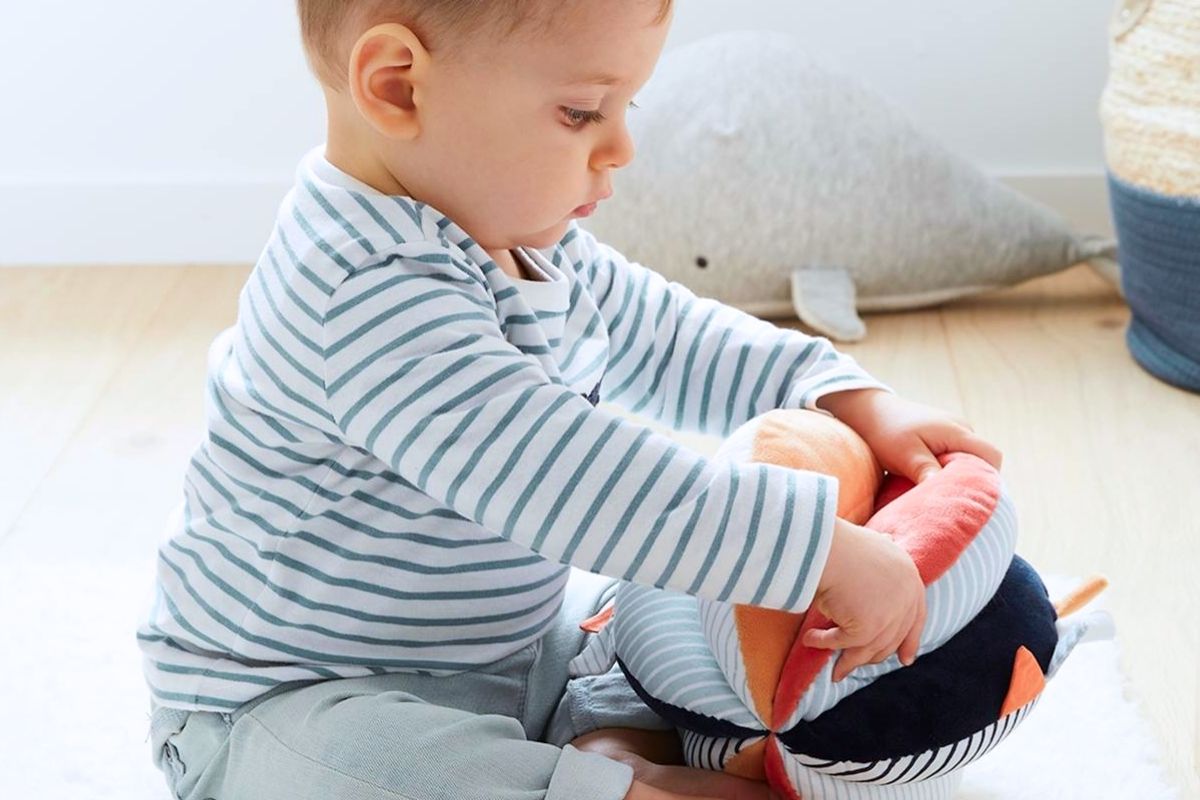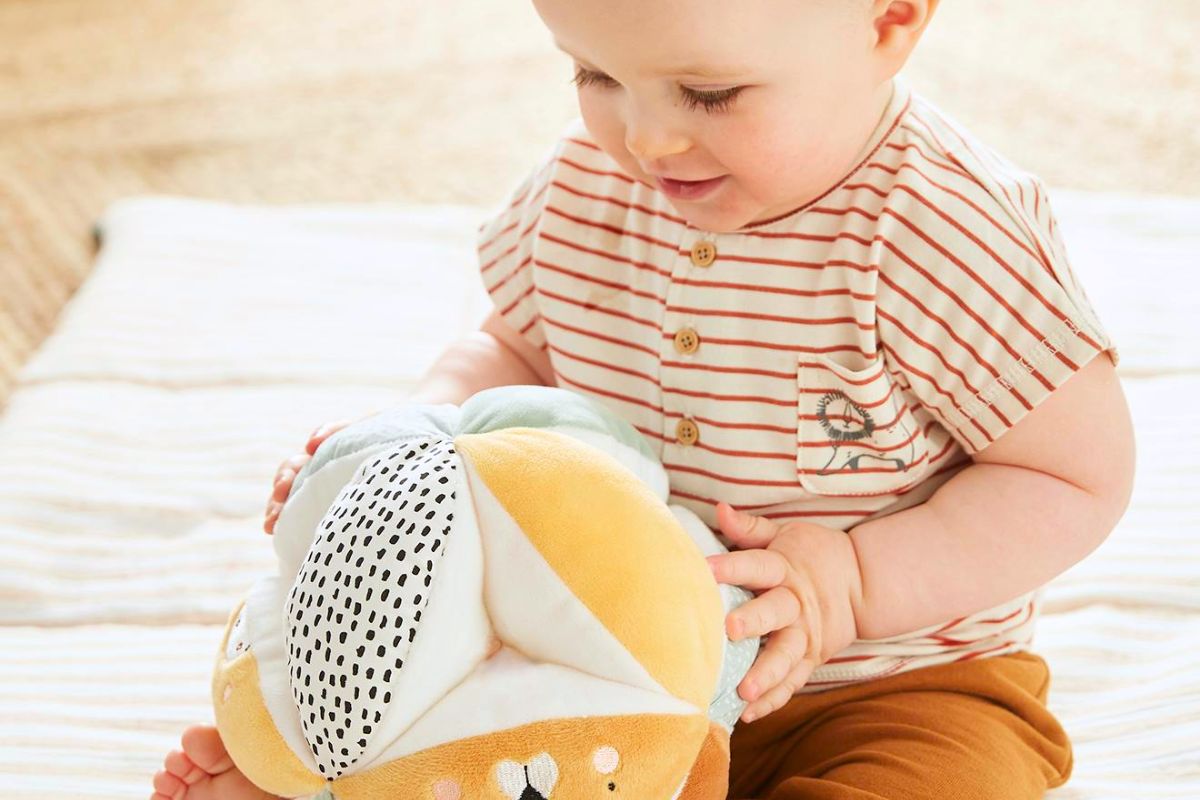The Montessori method, with its emphasis on sensorial material, has gained significant attention over the years for its ability to nurture children’s growth through play-based learning. An essential instrument in the Montessori material is the sensory ball. In this article, we’ll delve into the essence of Montessori sensory balls, their purpose, benefits, and how you can introduce and use them effectively with your little ones.
Key Takeaways
- Montessori sensory balls are introduced around 5-6 months, catering to infants up to 18 months.
- They are designed to stimulate senses, especially touch and vision.
- Contrasting colors are used to appeal to a baby’s visual sensitivity.
- The Montessori puzzle ball is notable for its grasp-friendly design.
- Some sensory balls have varied textures or contain smaller balls, enhancing motor skills and tactile exploration.
- Given infants’ tendency to mouth objects, it’s vital to choose balls free from harmful chemicals.
What are Montessori Sensory Balls
Sensory balls, often referred to as baby balls or Montessori balls, are soft-textured spheres that come in diverse sizes, colors, and materials. Their primary design is to stimulate a child’s senses while simultaneously promoting physical activity and coordination. These versatile toys are more than just playthings; they play a crucial role in fostering motor skills development, enhancing visual tracking abilities, and facilitating tactile exploration—an integral part of Montessori education.
Specifically tailored for infants, they are primarily introduced between 0-12 months, though their usage can sometimes extend up to 18 months. Infants are typically first exposed to these balls around 5-6 months. With an emphasis on touch and vision, their contrasting colors cater to an infant’s developing visual sensitivity. A standout variant in the Montessori sensorial material collection is the Montessori puzzle ball or fabric sensory ball, crafted with contrasting fabrics for easy grasping and can even double as a mobile for younger infants.
Given the variety available, some sensory balls boast different textures or even contain smaller balls within, further aiding in honing a baby’s tactile exploration and independence. With infants’ natural inclination to mouth objects, it’s paramount for parents to ensure these balls are made of quality materials, free from harmful chemicals.
Purpose and benefits of Montessori Sensory Balls
In a Montessori prepared environment, sensory balls are introduced primarily to inspire curiosity, engage the senses, and foster independence in learning through play. These balls present a multitude of advantages, offering diverse opportunities for children to explore and develop essential life skills.
- Motor Skills Development: Through actions like grasping, rolling, and manipulating, children enhance both their fine and gross motor skills.
- Hand-Eye Coordination: Tracking the movement of these balls helps children practice and refine their hand-eye coordination.
- Multisensory Experience: The diverse textures, sizes, and materials of the balls provide a rich sensory experience, boosting cognitive abilities such as memory, recognition, and problem-solving.
- Emotional Growth: The soft textures of the sensory balls can soothe anxious children, aiding in emotional regulation.
- Social Skills Cultivation: Group play with these balls fosters essential social skills, including communication, cooperation, and turn-taking.
- Tactile Discrimination: By exploring the subtle differences between the balls, children develop a refined sense of touch and learn to distinguish between various materials.
- Attention and Focus: Attempting to control a rolling or bouncing ball teaches children perseverance, enhancing their focus and attention span.
Different Types of Montessori Sensory Balls
By providing varied textures, sounds, and visual stimuli, sensory balls offer a rich and diverse learning experience, allowing children to explore, discover, and understand the world around them. Let’s delve deeper and explore the different types of Montessori sensory balls and their unique attributes:
Montessori Textured Sensory Balls in Silicone
These balls are made of silicone and come with varied textures on their surfaces.
- Age Appropriate: Suitable for babies as young as a few months old.
- Purpose: To stimulate the sense of touch and introduce babies to different tactile experiences.
- Characteristics: Non-toxic, BPA-free, easy to clean, and often come in bright colors.
Montessori Sensory Balls with Sound or Light
These sensory balls are equipped with mechanisms that produce sound or light when interacted with.
- Age Appropriate: Generally suitable for babies aged 6 months and above.
- Purpose: To stimulate multiple senses simultaneously – touch, hearing, and sight.
- Characteristics: Often made of soft, squeezable material. The sound can be a gentle rattle or a series of musical notes. The light feature is usually activated upon impact.
Fabric Sensory Ball
Crafted from various fabric materials, these balls can be soft and squishy or slightly firm.
- Age Appropriate: Suitable for newborns and up, depending on the size and type of fabric.
- Purpose: To introduce babies to different fabric textures and to enhance their grip.
- Characteristics: Often handmade, can be filled with materials like cotton, beans, or other soft fillings. They might have ribbons, tags, or other attachments for added tactile exploration.
Puzzle Ball
These are multi-segmented balls, often made of fabric, that challenge babies and toddlers to explore and manipulate.
- Age Appropriate: Best for babies aged 6 months to 2 years.
- Purpose: To develop motor skills, problem-solving abilities, and hand-eye coordination.
- Characteristics: Made up of several segments or pieces that fit together. They can be soft or firm, depending on the material.
Sensory Reflective Balls
These Montessori sensory reflective balls are made of shiny, reflective materials that captivate children’s attention, offering a mirrored view of the environment.
- Age Appropriate: Suitable for babies aged 6 months and above.
- Purpose: To stimulate visual senses and promote exploratory play, encouraging children to understand concepts of reflection and symmetry.
- Characteristics: Often made of durable, child-safe materials. They reflect light and surroundings, allowing children to observe reflections, light patterns, and even their own image.
| Type of Ball | Material | Age Range | Purpose | Characteristics |
|---|---|---|---|---|
| Montessori Textured Sensory Balls in Silicone | Silicone with varied textures | Few months old and up | Stimulate touch; introduce varied tactile experiences | Non-toxic, BPA-free, easy to clean, bright colors |
| Montessori Sensory Balls with Sound or Light | Soft, squeezable material with sound/light mechanisms | 6 months and above | Stimulate multiple senses – touch, hearing, sight | Soft material, gentle rattle or musical notes, light activated upon impact |
| Fabric Sensory Ball | Various fabric materials | Newborns and up | Introduce different fabric textures; enhance grip | Often handmade, fillings like cotton/beans, may have ribbons or tags |
| Puzzle Ball | Often fabric, multi-segmented | 6 months to 2 years | Develop motor skills, problem-solving abilities, hand-eye coordination | Segmented or pieces that fit together, soft or firm depending on material |
| Sensory Reflective Balls | Shiny, reflective materials | 6 months and above | Stimulate visual senses; promote exploratory play | Reflect light and surroundings, durable, child-safe materials |
Introducing and Using Montessori Sensory Balls in Playtime
Steps to Integrate Montessori Sensory Balls
To integrate Montessori sensory balls effectively into your child’s playtime, follow simple yet intentional steps:
- Select sensory balls made from different materials and various textures to provide a broad range of experiences. Choose balls age-appropriate for your child.
- Create a conducive environment, offering enough space for children to confidently move and interact with the toys.
- Prioritize safety by supervising play and having open communication about potential hazards.
- Incorporate games suitable to group or individual play to promote social skills and independence.
- Maintain an engaging atmosphere by offering encouraging feedback and celebrating achievements.
Using Montessori Sensory Balls for Babies
Babies should be introduced to sensory balls starting at an early age. Sensory balls effectively engage infants in multi-sensory experiences that foster cognitive and motor skill development from the beginning stages of life. Playful activities involving sensory balls for babies may include:
- Gently placing the ball on the baby’s tummy to encourage them to use their hands and feet to explore it.
- Rolling the ball back and forth, encouraging eye contact with both the toy and caregiver.
- Tossing or shaking the ball gently to trigger the baby’s excitement and attention.
- Letting the baby freely explore the texture, size, and material of the sensory ball with their mouth and fingers.
Montessori Sensory Balls Activities
The following chart provides a breakdown of various activities and their associated benefits when using these sensory balls. Each activity is designed to cater to specific developmental milestones, ensuring a holistic approach to learning and growth.
| Activity | Description |
|---|---|
| Basic Exploration | Allow the child to freely explore the sensory ball by touching, squeezing, rolling, and observing to understand its texture, weight, and other properties. |
| Rolling and Tracking | Roll the ball back and forth with the child to develop hand-eye coordination as they track and try to catch or stop the ball. |
| Texture and Tactile Exploration | If using sensory balls with varied textures, encourage the child to feel each one and discuss the differences, enhancing tactile discrimination. |
| Grasping and Transferring | Younger infants can practice motor skills by grasping the ball and transferring it between hands. |
| Sound and Light Exploration | If the ball has sound or light features, engage the child’s auditory or visual senses. For example, shaking a rattling ball. |
| Group Play | Engage multiple children in activities like rolling the ball to each other or playing catch, promoting social interaction and cooperation. |
| Hide and Seek | Hide the ball under a cloth or inside a container, encouraging the child to find it, aiding in the development of problem-solving skills. |
Pairing Montessori Sensory Balls with Other Materials
The versatility of Montessori sensory balls enables them to be paired with other educational materials, subsequently providing enriched learning opportunities. Some combinations ideas include:
- Sensory Bins: Incorporating balls into sensory bins filled with various natural materials can heighten tactile exploration while refining fine motor skills.
- Ramps and Inclined Planes: Rolling sensory balls down inclines or using climbing toys can help improve coordination, reaction speed, and understanding of cause-and-effect relationships.
- Basket Sorting: Sorting sensory balls by texture, size, or color is an excellent activity for promoting cognitive development and enhancing visual tracking abilities.
- Obstacle Course: Setting up an obstacle course using a variety of Montessori materials and incorporating sensory balls can encourage children to experiment with various ways to move, further boosting gross motor skills.
In conclusion, introducing Montessori sensory balls as part of play-based learning experiences provides endless opportunities for child development. Whether you’re a parent or an educator, integrating sensory balls into your environment will contribute positively to the growth and progress of children in your care. If you’re interested in creating your own, check out our article on DIY Montessori sensory ball for step-by-step instructions and tips







